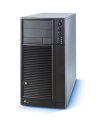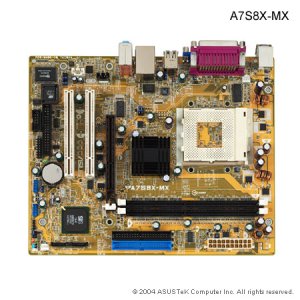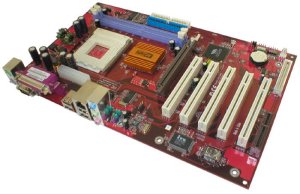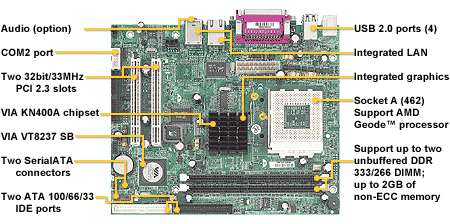By replacing the components of an existing server you can save a lot of energy. In this part I will tell you about the problems encounter finding the right motherboard, the non-standard connectors of Intel case and the saving which I have made on power consumption…

This article is the sequel of the previous article “Building a low power consuming server (1)”.
Motherboard
Finding a good motherboard for the low power AMD Geode NX processor seems easy, however it has proven to be the toughest task during the re-build of my server.
The AMD Geode NX processor has a Socket A.

The AMD Geode NX 1500 processor
So I first started searching for a good motherboard for the processor. My goal was a lower power consuming server, therefore a fully integrated motherboard with all necessary IO / Video components on boards saves on separate PCI / AGP cards, and thus on power usage. I searched for a motherboard with integrated VGA video, Ethernet LAN (minimum 100 Mbps) and a SATA controller.
My search on the internet resulted in the following motherboard.
Asus A7S8X-MX
The Asus A7S8X-MX motherboard is a socket A motherboard and has the SiS 741GX chipset. On the internet I have found that this chipset works best together with the AMD Geode processor. This motherboard has also integrated VGA, network 100 Mpbs and two SATA connections. Ideal for our new server.

Asus A7S8X-MX motherboard
After booting the PC I got the following BIOS message “unknown processor”, that isn’t looking too good. Starting my linux server resulted in a stall, the boot process just stopped. When I changed the boot options in GRUB to: acpi=off, apm=off resulted in a booting server. However, with these options off Linux cannot perform any powermanagenent on the CPU and this is one of the ways to save energy. So disabling these options is a bad thing.
One other problem popped-up, the server wouldn’t reboot. After a reboot the server was stalling again. Only with a full power-down the server would boot.
So I contacted ASUS technical support, that did not help. After some mail exchange and a bios upgrade I found out that this processor is no priority for ASUS and is not (yet) supported (July 2006).
After this disappointing experience I went searching for another motherboard. Again after searching the internet I found the following motherboard:
ASRock K7S41GX
This ASRock motherboard is also socket A and has also the SiS 741GX chipset. This motherboard has integrated VGA and 100 Mbps LAN. The AMD Geode NX processor is even on the list of supported processors, so you expect nothing can go wrong now…..

ASRock K7S41GX motherboard
After the boot of the PC I got the message from the BIOS that the processor is recognised as an Mobile Athlon processor. This is looking better, but wait, shouldn’t it be a AMD Geode processor? After some investigation I found that he AMD Geode NX processor is identical to the Mobile Athlon processor were they have changed it to socket A, so it can be used in desktop PCs. This explains why it is a low power processor.
However, there is still a problem. The processor is running to fast. This is good for gamers who want to overclock their processor to get more power out of a cheaper processor, however this is very bad for energy usage. Again after some investigations I found the problem, the Vcore voltage of the motherboard is too high. The Vcore voltage of the motherboard is 1,4 Volt while the processor needs 1,250 Volt. Unfortunately I cannot change this Vcore voltage in the BIOS settings or via jumpers on my motherboard.
Another problem is that the BIOS on this motherboard has not the right PST tables for the AMD Geode NX processor. The PST tables contain the available powerstates for the processor. These powerstates are needed for good power management using ACPI. And good power management is important for low power usage of the PC.
Contacted technical support of ASRock, but unfortunately they couldn’t help. Stuck again.
Back searching on the internet for a solution: I found the following offer: a motherboard with AMD Geode processor included (attached), this must be the solution……
PCCHIPS 811 with AMD Geode 1750 NX
The PCCHIPS 811 motherboard ships with a attached AMD Geode 1750 NX processor and a custom BIOS with AMD Geode processor support. Perfect, this cannot go wrong….I thought.
PCCHIPS 811 motherboard
After re-building the server again with this new motherboard, I started to get experienced with this, I have started the server again. Indeed, the BIOS shows that it recognises the Mobile Athlon processor. Lets see what the Vcore voltage is. What a surprise, still 1.4 Volt. Again too high! Unbelievable. Bought a special motherboard with attached AMD Geode processor, custom BIOS, and still the Vcore voltage is too high.
Again contacted technical support of PCChips, no solution was found.
I have tested this motherboard some time in the re-builded server. The overclocked processor, due to the too high Vcore voltage, became so hot that it had to shutdown itself. This is a standard precaution of AMD processors. This motherboard is clearly no candidate for my low power server.
Of to my next (and hopefully last) attempt to find the right motherboard. Again after searching the internet i found a new candidate. A motherboard which only supports the the AMD Geode NX processor. Will I succeed now…
Tyan Tomcat K7M 2498AGNN
This motherboard has also integrated VGA, two LAN (100 Mbps / 1000 Mbps) and two SATA connections. It is a mini-ATX (mATX) so it will not take less space compared with a full size desktop motherboard.

The Tyan Tomcat K7M 2498AGNN motherboard
After the boot it looks promising. The BIOS recognises the processor and the server boots without any problems. Checked the Vcore: 1.250 Volt. Perfect! Finally a motherboard which fully supports the low power AMD Geode processor.
Savings
The first measurements with my Energy-Check 3000 power measurement device indicate that the server is now using a lot less power. Power usage is down to only 95 Watt. We also performed some more extensive power measurements on this server. The details will soon be published on this website. These extensive power measurements show that the server uses now 90 Watt of power.
The old server, before the re-build, used continuous 250 Watt power. This is now a reduction of 250 Watt – 90 Watt = 160 Watt. This results in a annual saving of 24 hours x 7 days x 365 days x 160 Watt = 1400 kWh. This is more than my first 12 solar panels can provide.
Finishing touches
After the solving the biggest blocking issue, finding the right motherboard for my AMD Geode NX processor, we need to finished the re-build. This included connecting buttons and led lights of the case with the motherboard. The old server consisted of an Intel motherboard and a nice Intel server case. Unfortunately the connector between the server case and the Intel motherboard is proprietary and does not fit on a standard motherboard. Therefore I could not connect the power and reset button (the most important buttons) of the case.
However this can be solved easily by measuring which pins are used while pressing the reset and power button. I took some older smaller standard connectors (fitting on the motherboard) and attached them to the proprietary Intel conector using the right pins. This solved the problem.
Conclusion
During the re-build of the server I found out that making low power computers is still pioneering work. Most people are currently interested (this is slowly changing now) in overclocking processors to make them speedier instead of make them use less power. Not many people have experience with low power processors and how to use them effectively. The motherboard support for the AMD Geode processor is very bad. It took me 4 different motherboard (vendors) to find the right motherboard. Looking at the specification of the motherboard alone was not enough.
Despite these setbacks, the server conversion process was a success. The achieved annual savings of 1400 kWh is significant. Meanwhile the low power server is running for several months now without any problems.
It makes sense to check your house for equipment which is 24 hours on and if you can save on them. With a relatively small investment to make the device use less power (or to replace it) you can save annually a lot of energy.
Update
In the upcoming article “Building a low power consuming server (3)” I will show how we can save an additional 30 Watt by optimising the configuration of the server.





13 replies on “Building a low power consuming server (2)”
Thanx for the heads up dude. Currently on the rampage for info like this. James
Hay
Do you remember which version of bios was for ASRock K7S41GX or when do you test motherboard?
I have one lieing around, updated to virsion 2.8. Maybe is now supporting geode nx properly.???
http://www.asrock.com/mb/download.asp?Model=K7S41GX&o=BIOS
The game’s graphics are appealing and captivating, making them a favorite among players. The fact that the game’s intricacies are so meticulously crafted contributes to the overall enjoyment of playing it.
Type with precision and comfort using the Dell Keyboard, designed for seamless performance. Get yours now at The Brand Store for the best deals!
Vegas Vapor is your go-to online vape shop, offering premium e-liquids,Pod Kit, and disposable vapes at unbeatable prices. We provide authentic products, fast shipping, and exceptional customer service to enhance your vaping experience. Shop with confidence and enjoy the best in vaping!
Great article! When it comes to getting your book published, partnering with professional book publishers is essential. At Turner Book Writers, we pride ourselves on offering comprehensive publishing solutions, from editing to distribution. Our goal is to ensure your book is polished and ready for success. If you’re looking for a trusted publishing service, look no further!
Kanye West Merch Official Shop. Enjoy UP TO 50% OFF on a range of items including Hoodies, Tees, Sweatshirts, Sweatpants & Accessories.
great
great article
great
Lawyer in Virginia
Great
Lawyer in Virginia
Great article! When it comes to getting your book published, partnering with professional book publishers is essential. At Turner Book Writers, we pride ourselves on offering comprehensive publishing solutions, from editing to distribution. Our goal is to ensure your book is polished and ready for success. If you’re looking for a trusted Lawyer in Virginia, look no further!